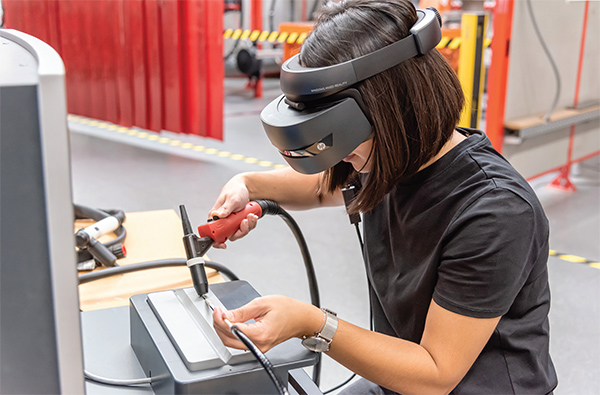Philipp Schlor, product manager for Virtual Welding at Fronius International, presents the argument for using modern virtual technology for welder training. Using field study data from the Fohnsdorf Training Centre in Austria, he reveals that using the Fronius Virtual Welding simulator gives student welders 23% more practice time and reduces material costs by €230 per student.
Click to download and read pdf
With no noise, no heat and no need for expensive consumables or materials, virtual welding provides a totally safe and sustainable framework for training prospective welders. As with a flight simulator, 3D glasses and outstanding graphics provide a realistic welding experience: the result being improved effectiveness, better skills levels and significantly reduced costs for welder training programmes.

A holistic training approach to theory and practice
With virtual welding, Fronius has developed a well-thought-out training approach that includes imparting theoretical knowledge of the MIG/MAG, TIG, and MMA processes, which also incorporates knowledge tests, with a ranking list motivating students to gauge their performance in relation to others.
The practical welding tasks in Fronius Virtual Welding lesson plans are based on the training offered by the International Institute of Welding (IIW). This means that they correspond to the international standard for training welders.
Ghost: the trainer always by your side
To master the manual skills required, the trainee practices first with a virtual teacher, also referred to as the Ghost. Step by step, the Ghost specifies exactly the right welding speed, distance and angle of the welding torch to the workpiece. Trainees therefore receive direct feedback from the Ghost. The degree of difficulty of the task gradually increases until welding is eventually being performed without the Ghost, in realistic simulation mode.
With Virtual Welding, the welding operations are recorded, and can subsequently be played back and analysed together with the real trainer.
This combination of guided practical exercises and theoretical units allows the trainee to use the welding simulator to independently complete many of the training phases. In this way, trainees master the basic knowledge and the essential manual skills before working with a real welding system. Training equipment can therefore increase training effectiveness, while reducing costs.
Field study: Fohnsdorf Training Centre
The Fohnsdorf Training Centre, SZF for short, is one of the most modern and innovative facilities for professional training in Austria. The SZF has been using virtual welding in the metalworking sector since 2010, and 30% of practical welder training is now being carried out by means of simulation. As a result, this is a fixed component of the training content.
Research was conducted into what effects this has had on the effectiveness of the training by means of a field study. Data were analysed from 13 trainees over two weeks of training with 30% of the time being spent on virtual welding and 70% on real welding. Fillet welds on plate – done according to the EN ISO 135 P FW FM1 S PB ml fillet welder performance qualification test – and fillet welds on pipes – according to the 135 T FW FM1 S PB sl qualification test – were each welded in both the real and the virtual environment.
To determine the cost effectiveness of training using virtual welding, the metal, gas, welding wire and energy consumed by a total of 1 577 real weld seams were also analysed and compared with data from 1 733 virtual weld seams.
Improved training quality due to 23% more practice time
Using virtual welding, the SZF was able to increase the time actually spent welding by 23%. This means that more than three times as many seams can be produced virtually than by spending the same amount of time in the welding booth. The main reason for this is that with virtual welding, there is no time-intensive preparation of test sheets, nor the need for cooling the metal sheets and cleaning the weld seams. A simulated weld seam only requires a click, leaving more time for mastering and practicing the required manual skills.
But it is not only the practice time that increases: “First of all, we see the use of Virtual Welding as an important contribution to improving training quality. The Ghost gives every student individual support and direct visual feedback – something a real trainer simply cannot achieve,” says a convinced Hannes Krempl, a trainer in welding technology and transport at SZF.
Cost saving: material costs reduced by €230
As well as improving the quality of the training, the welding simulator also increases the cost efficiency: by saving on consumables such as gas, wire and metal sheets, training becomes far less expensive. “The targeted use of virtual welding saves us, in total, around €230 per student in materials’ costs – despite the increased arc time,” calculates Krempl.
In addition, virtual training guarantees that the real portion of welder training will be significantly more effective, requiring far less time and fewer resources to get a welder ready to successfully complete the welder performance qualification test.













